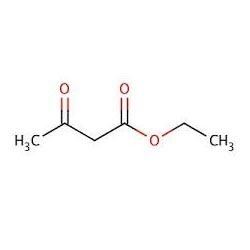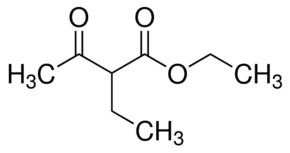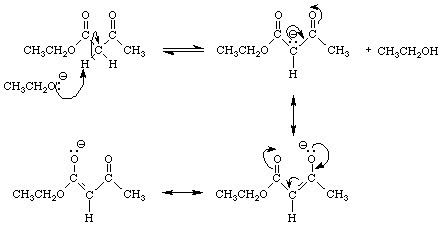Formula C6H10O3 Molar mass 130.14 g/mol Melting point -45 °C | Density 1.02 g/cm³ Boiling point 180.8 °C Appearance Colourless liquid | |
Related compounds | ||
Synthesis of ethyl acetoacetate
The organic compound ethyl acetoacetate (EAA) is the ethyl ester of acetoacetic acid. It is mainly used as a chemical intermediate in the production of a wide variety of compounds, such as amino acids, analgesics, antibiotics, antimalarial agents, antipyrine and aminopyrine, and vitamin B1; as well as the manufacture of dyes, inks, lacquers, perfumes, plastics, and yellow paint pigments. Alone, it is used as a flavoring for food.
Contents

Preparation
Ethyl acetoacetate is produced industrially by treatment of diketene with ethanol.

The preparation of ethyl acetoacetate is a classic laboratory procedure. It is prepared via the Claisen condensation of ethyl acetate. Two moles of ethyl acetate condense to form one mole each of ethyl acetoacetate and ethanol.
Reactivity

Ethyl acetoacetate is subject to keto-enol tautomerism. Ethyl acetoacetate is often used in the acetoacetic ester synthesis similar to diethyl malonate in the malonic ester synthesis or the Knoevenagel condensation. The protons alpha to carbonyl groups are acidic, and the resulting carbanion can undergo nucleophilic substitution. A subsequent thermal decarboxylation is also possible. Similar to the behavior of acetylacetone, the enolate of ethyl acetoacetate can also serve as a bidentate ligand. For example, it forms purple coordination complexes with iron(III) salts:
Ethyl acetoacetate can also be reduced to ethyl 3-hydroxybutyrate.

Ethyl acetoacetate, when heated alone (uncatalyzed) with benzyl alcohol, forms synthetically useful benzyl acetoacetate (benzyl groups being easily removed later by catalytic hydrogenolysis over Pd/C under neutral conditions), via a mechanism involving acetylketene. Ethyl (and other) acetoacetates nitrosate readily with equimolar sodium nitrite in acetic acid, to afford the corresponding oximinoacetoacetate esters. A dissolving-zinc reduction of these in acetic acid in the presence of ketoesters or beta-diketones constitute the Knorr synthesis of pyrroles, useful for porphyrin synthesis.


